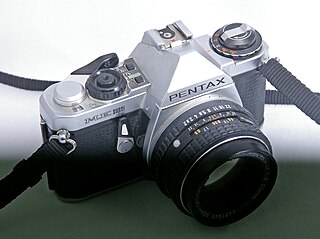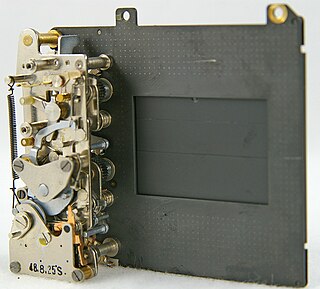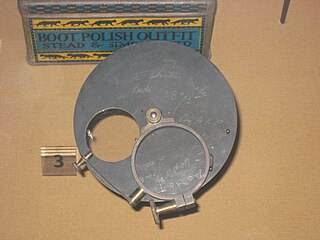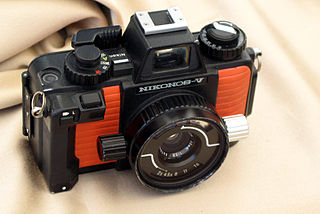
A single-lens reflex camera (SLR) is a camera that typically uses a mirror and prism system that permits the photographer to view through the lens and see exactly what will be captured. With twin lens reflex and rangefinder cameras, the viewed image could be significantly different from the final image. When the shutter button is pressed on most SLRs, the mirror flips out of the light path, allowing light to pass through to the light receptor and the image to be captured.

A camera is an optical instrument used to capture and store images and videos, either digitally via an electronic image sensor, or chemically via a light-sensitive material such as photographic film. As a pivotal technology in the fields of photography and videography, cameras have played a significant role in the progression of visual arts, media, entertainment, surveillance, and scientific research. The invention of the camera dates back to the 19th century and has since evolved with advancements in technology, leading to a vast array of types and models in the 21st century.

A view camera is a large-format camera in which the lens forms an inverted image on a ground-glass screen directly at the film plane. The image is viewed and then the glass screen is replaced with the film, and thus the film is exposed to exactly the same image as was seen on the screen.

A twin-lens reflex camera (TLR) is a type of camera with two objective lenses of the same focal length. One of the lenses is the photographic objective or "taking lens", while the other is used for the viewfinder system, which is usually viewed from above at waist level.

The Speed Graphic was a press camera produced by Graflex in Rochester, New York. Although the first Speed Graphic cameras were produced in 1912, production of later versions continued until 1973; with significant improvements occurring in 1947 with the introduction of the Pacemaker Speed Graphic.

A flash is a device used in photography that produces a brief burst of light at a color temperature of about 5500 Kelvin to help illuminate a scene. A major purpose of a flash is to illuminate a dark scene. Other uses are capturing quickly moving objects or changing the quality of light. Flash refers either to the flash of light itself or to the electronic flash unit discharging the light. Most current flash units are electronic, having evolved from single-use flashbulbs and flammable powders. Modern cameras often activate flash units automatically.

In photography, flash synchronization or flash sync is the synchronizing the firing of a photographic flash with the opening of the shutter admitting light to photographic film or electronic image sensor.

In camera design, a focal-plane shutter (FPS) is a type of photographic shutter that is positioned immediately in front of the focal plane of the camera, that is, right in front of the photographic film or image sensor.

The Holga is a medium format 120 film camera, made in Hong Kong, known for its low-fidelity aesthetic.
Panoramic photography is a technique of photography, using specialized equipment or software, that captures images with horizontally elongated fields of view. It is sometimes known as wide format photography. The term has also been applied to a photograph that is cropped to a relatively wide aspect ratio, like the familiar letterbox format in wide-screen video.

Candid photography is photography captured without creating a posed appearance. This style is also called street photography, spontaneous photography or snap shooting. Professional photographers sometimes shoot candid photos of strangers on the street or in other public places such as parks and beaches. Candid photography captures natural expressions and moments that might not be possible to reproduce in a studio or posed photo shoot. This style of photography is most often used to capture people in their natural state without them noticing the camera. The main focus is on capturing the candid expressions and moments of life. Candid photography can be used in a variety of settings such as family gatherings, special events, and everyday street scenes. It is also a popular choice for wedding photos and professional portraits. Candid photography is often seen as a more honest representation of the subject than posed photography. To capture candid photos, the photographer may need to observe the subject from a distance or use a long lens or telephoto zoom lens. This allows for capturing the subject in their natural environment without them being aware of the camera. The photographer may need to be quick and have an eye for interesting compositions and backgrounds.

Monorail cameras are view cameras with lens mount, bellows, and interchangeable viewing and film backs all fitted along a rigid rail along which they can slide until locked into position.

When setting photoflash exposures, the guide number (GN) of photoflash devices is a measure photographers can use to calculate either the required f‑stop for any given flash-to-subject distance, or the required distance for any given f‑stop. To solve for either of these two variables, one merely divides a device's guide number by the other.

In photography, a shutter is a device that allows light to pass for a determined period, exposing photographic film or a photosensitive digital sensor to light in order to capture a permanent image of a scene. A shutter can also be used to allow pulses of light to pass outwards, as seen in a movie projector or a signal lamp. A shutter of variable speed is used to control exposure time of the film. The shutter is constructed so that it automatically closes after a certain required time interval. The speed of the shutter is controlled either automatically by the camera based on the overall settings of the camera, manually through digital settings, or manually by a ring outside the camera on which various timings are marked.

Nikonos is the brand name of a series of 35mm format cameras specifically designed for underwater photography launched by Nikon in 1963. The early Nikonos cameras were improvements of the Calypso camera, which was an original design by Jacques-Yves Cousteau and Belgian engineer Jean de Wouters. It was produced in France by La Spirotechnique until the design was acquired by Nikon to become the Nikonos. The Nikonos system was immensely popular with both amateur and professional underwater photographers. Its compact design, ease of use, and excellent optical quality set the standard for several decades of underwater imaging. Nikon ceased development and manufacture of new Nikonos cameras in 2001, but the camera remains popular, and there is a large and active secondary market.

Night photography refers to the activity of capturing images outdoors at night, between dusk and dawn. Night photographers generally have a choice between using artificial lighting and using a long exposure, exposing the shot for seconds, minutes, or even hours in order to give photosensitive film or an image sensor enough time to capture a desirable image. With the progress of high-speed films, higher-sensitivity digital sensors, wide-aperture lenses, and the ever-greater power of urban lights, night photography is increasingly possible using available light.
The following outline is provided as an overview of and topical guide to photography:

Sports photography refers to the genre of photography that covers all types of sports.

Landscape photography shows the spaces within the world, sometimes vast and unending, but other times microscopic. Landscape photographs typically capture the presence of nature but can also focus on human-made features or disturbances of landscapes. Landscape photography is done for a variety of reasons. Perhaps the most common is to recall a personal observation or experience while in the outdoors, especially when traveling. Others pursue it particularly as an outdoor lifestyle, to be involved with nature and the elements, some as an escape from the artificial world.

Terry deRoy Gruber is an American photographer, author and filmmaker.


















